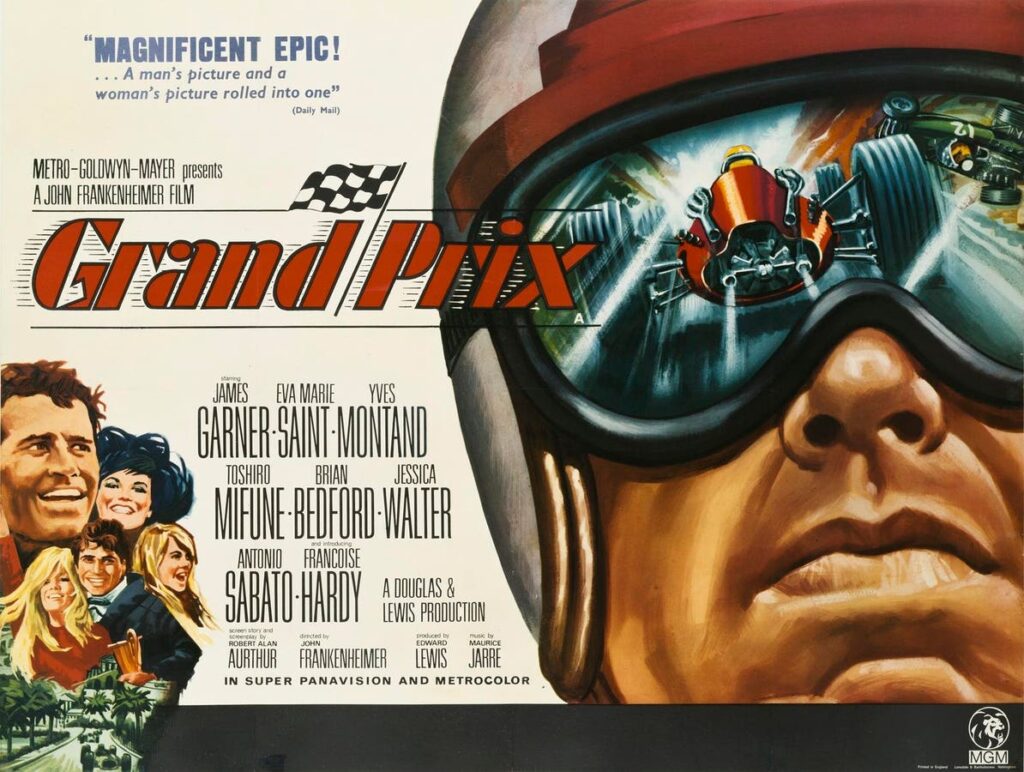Even with cutting-edge technology and every component brimming with innovation, there is always space for improvement and creative solutions, even after a product hits the market, or in this case, the cameras are rolling. An important innovation lesson from the movie “Grand Prix.”
There’s an inspiring behind-the-scenes photograph from John Frankenheimer’s 1963 GRAND PRIX film that carries a vital innovation lesson.
It shows actor James Garner, his face covered by exhaust fumes and burned petrol makeup, seated in his racing car. A heavy 16mm Panavision camera faces him. This is no ordinary camera. It’s remotely controlled by a military-grade missile system.
And here is the catch: The entire apparatus is held together with a rubber band.
The movie had an impressive star list; alongside Garner, it featured Yves Montand. The posters and marketing promised “All the glamour and the greatness of the world’s most exciting drama of speed and spectacle!” If you had the patience to stay in your theater seat for three hours, that is. Of course, these were the days before YouTube shorts and TikTok. Three-hour movies were typical, smoking in theaters was permitted, and rolling an empty bottle of Coke down the aisles was a regular gag.
If you can find a copy (often the full version appears on YouTube), you can enjoy the film that defines how action movies look today. Shots like a low PoV view of a car racing through the narrow streets of Monaco. The dramatic shot of a driver is as if the camera is hanging on the rear side mirror, simultaneously looking at the car, the driver, and the road, filmed while the vehicle is in motion: all common today, but an innovation in the early 60’s. All featured in “Grand Prix.”
To capture action in film involving cars, movies before the “Grand Prix” shot vehicles from a distance, from the POV of a spectator. Filming moved to the studio if the script demanded a headshot of the driver or some in-car action scene. So how did the director create the fast motion of a car in a studio environment? It went something like this: a couple of well-positioned and muscular guys hidden from the camera would shake the car back and forth, while on a screen behind the car, a separate movie projected the background scene to create the impression the car is moving.
In movie terminology, this is called “rear projection.” The result gave the impression that the car was racing along, but these shots did not age well. If you watch any old James Bond (or Elvis Presley movie, for that matter), you can identify these shots, and they look—well, in the world of Visual Effects, not convincing.
The Innovation
What Frankenheimer did in “Grand Prix” was revolutionary and still looks exciting today, as he shot all the action scenes on the racing track. For that, he and his team had to come up with a series of groundbreaking innovations to create real-life PoV shots of the race and to place the viewer not in the spectator’s seat but in the driver’s seat. Here is a partial list of the innovations needed to create the action shots that redefined cinema action movies:
- Camera rigs: Design and engineer 150-pound camera rigs fitted on Formula racing cars to provide unique and exciting PoV shots without upsetting the car’s balance at racing speeds.
- Remote control: All these camera rigs were remote controlled (for the IoT enthusiasts out there, this is in 1963…), using technology initially designed to track missiles remotely, so the film crew could control the shots, the position and angle of the camera, the focus, and the aperture from a mile away. Amazing.
- Communication: Motorola designed specialty helmets; this way, the producer, director, film crew, and drivers could discuss shots as they filmed the action sequences on-site while the cars were moving at Formula car speeds.
- Pre-drone era heli shots: New lenses and helicopter rigs were developed to create close shots of the racing driver that smoothly zoomed out to capture the entire racing track.
This is just a short list of the many innovations needed to create this new style of action film. It is all done on-site; the viewer is in the driver’s seat, and there are none of the old-style studio rear projection scenes.
And yet, after all of the planning and engineering, we still have this fantastic behind-the-scenes shot. James Garner in the drivers seat, face covered by exhaust fumes and burned petrol makeup. A heavy 16mm Panavision camera on the remote-controlled rigs described above is facing him. And it’s all held together with a rubber band.
Somehow, after all the designs, mockups, engineering, and meticulous craftsmanship ensuring the cars stay balanced at speeds over 150 miles per hour with a 150-pound rig hanging off to the side of the car when the tires hit the road (literally), it was a $3 rubber band that kept everything in place.
The Lesson
We often confuse innovation with the initial process of developing an idea that matters. But this is not true. Innovation also occurs when the product is out there in the wild, performing and creating a measurable human, social, or business impact, which means that the innovation process never ends. Even once the product leaves the labs, there is room for innovation and improvement—a quick hack, a smart adjustment, a fix to the pricing model.
A rubber band to hold it all in place. A small nudge that keeps the product rolling.
If you are an innovator, you must follow your innovation well beyond its launch day. There’s always an opportunity to improve, optimize, personalize, and modify the user’s experience—yes, even when the cameras are rolling and the car races 150 miles per hour with James Garner and Yves Montand in the winding streets of Monaco.
Read the full article here


